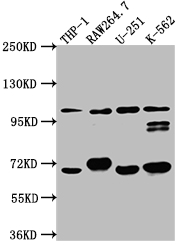TLR5 is expressed constitutively in epithelial cells and immune cells, such as monocytes and immature DCs. TLR5 is preferentially expressed on the apical side of respiratory epithelia in both mice and humans. Thus, TLR5 can induce early signaling dedicated to protective innate immune responses against respiratory infection. Mammalian TLR5 binds flagellin as an indicator of bacterial infection. TLR5 recognizes the conserved domain in flagellin monomers and triggers proinflammatory responses. TLR5 plays a crucial role in both immune homeostasis and protection against bacterial infection in mammals, birds, amphibians, fish, and reptiles.
The generation of this recombinant TLR5 antibody occurs in a series of steps: immunization, splenocytes & PBMC, single B cell sorting, mRNA extraction, RT-PCR & insert vector, expression, ELISA validation. And ELISA, WB was carried out Every step was performed under strict standards to ensure the researchers can have a recombinant TLR5 antibody with premium quality.






